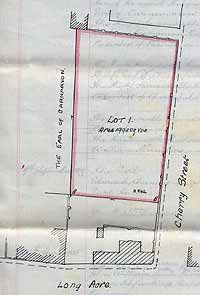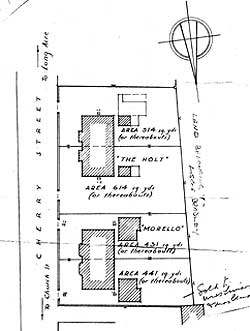![]()
8 Cherry Street
Summary
As with many properties in Bingham the story of 8 Cherry Street starts with the Earls of Chesterfield. It, along with numbers 2, 4 and 6 were built in or around 1920 on former orchards belonging to the Shelford Estate. The orchard was purchased from the Earl of Carnarvon in 1920 by Charles Christopher Hume Cadge, who owned the pharmacy in Market Street. The Rural District Surveyor and Sanitary Inspector, Cyril Walker Kendrick designed numbers 6 and 8. Mr Cadge occupied number 4 and rented out the others including number 8 to Mr Kendrick. Mr Cadge’s successors in title sold the four houses between 1951 and 1975. Mr Kendrick’s daughter still lives in the property (2010).
Review of Deeds Documents
The first document is an abstract of title to the land of the Earl of Carnarvon. This document records the inheritance by Evelyn Georgiana Countess of Carnarvon of much of her father the Earl of Chesterfield’s estate. This eventually passed to her son the fifth Earl of Carnarvon who discovered the tomb of Tutankhamun.
 The land was conveyed freehold to Cadge
on 15th July 1920 for the sum of £300. We know from
other deeds and land registry information that the Earl of
Carnarvon sold many freeholds in Bingham in 1920. He and Howard
Carter discovered Tutankhamen in November 1922 and were running
short of funds for the excavations. One suspects sale of freeholds
was one way of raising the cash. The land is described in
the conveyance:
The land was conveyed freehold to Cadge
on 15th July 1920 for the sum of £300. We know from
other deeds and land registry information that the Earl of
Carnarvon sold many freeholds in Bingham in 1920. He and Howard
Carter discovered Tutankhamen in November 1922 and were running
short of funds for the excavations. One suspects sale of freeholds
was one way of raising the cash. The land is described in
the conveyance:
All that piece or parcel of land situate on and having a frontage to Cherry Street in the Parish of Bingham containing by recent admeasurement one thousand nine hundred and ninety three square yards or thereabouts and bounded
to the North by hereditaments belonging to (space)
and towards the East by Cherry Street and towards the South West by othere hereditaments belonging to the Earl
and which said piece of land is now used as an orchard and in the occupation of (no forename) Little.
The 1922 Directory lists a Thomas Edward Little as a boot and shoe seller in Bingham Market Place, but we have no way of telling if this is the same Little mentioned as occupier of the orchard. A postcard from about 1920 shows the wall to the orchard clearly together with the shop at Dane Cottage opposite.
The annotation ‘Plot 1’ on a plan attached to the documents suggests this may have been part of a larger sale. The plan shows the access drive to the police station and court house (now the Old Court House) so the unnamed owner to the north would have been either Nottinghamshire Constabulary or the County Court.
North of this driveway, the freehold for 12 Church Street (and we suspect the other three villas there) was sold by the Earl on 22nd June 1920.
The description of the orchard plot suggests that what is now Regency House (65 Long Acre) was still in the Earl’s possession. We do not yet know when this freehold was sold.
As with similar sales the Earl retained the mineral rights. The Earl covenanted to maintain the southern boundary wall for ever but no mention is made of the western wall, also at that time owned by the Earl. Perhaps this indicates the Chesterfield Arms’ freehold was also being sold at the time, in which case responsibility for the boundary wall may have rested with the owner of that new freehold.
 We know from the present owner of number
8 that Cyril Kendrick designed the pair making up numbers
6 and 8. We do not who designed numbers 2 and 4, which were
probably built a few years later. Examination of the styles
and decorative features suggests they were all constructed
within a short time frame. The stained glass decoration of
the hall windows to 6 and 8 is somewhat more ornate than that
to numbers 2 and 4. But on the other hand Cadge and Kendrick
were to occupy the latter and the others were only for rent
to as yet unknown tenants! The different styles of the bay
windows between the pairs of houses might also suggest slightly
different build dates. The lounge windows of all four houses
strike one as being large for the period. Mr Kendrick was
keen that people should be able to see out of their windows
whilst seated. (Indeed he applied this principle to his design
of the first council houses in Bingham, at Nottingham Road/Stanhope
Way). The front garden wall to all the properties is fairly
evidently the original wall to the orchard, and probably lowered
with a view in mind! The gardens contain one or two original
orchard trees and number 8 has the remains of the well.
We know from the present owner of number
8 that Cyril Kendrick designed the pair making up numbers
6 and 8. We do not who designed numbers 2 and 4, which were
probably built a few years later. Examination of the styles
and decorative features suggests they were all constructed
within a short time frame. The stained glass decoration of
the hall windows to 6 and 8 is somewhat more ornate than that
to numbers 2 and 4. But on the other hand Cadge and Kendrick
were to occupy the latter and the others were only for rent
to as yet unknown tenants! The different styles of the bay
windows between the pairs of houses might also suggest slightly
different build dates. The lounge windows of all four houses
strike one as being large for the period. Mr Kendrick was
keen that people should be able to see out of their windows
whilst seated. (Indeed he applied this principle to his design
of the first council houses in Bingham, at Nottingham Road/Stanhope
Way). The front garden wall to all the properties is fairly
evidently the original wall to the orchard, and probably lowered
with a view in mind! The gardens contain one or two original
orchard trees and number 8 has the remains of the well.
A plan drawn in 1951, for the sale of number 2, shows that Cadge’s house occupied 614 square yards, a larger plot than the others, number 8 had 514 sq yds and numbers 2 and 4 441 sq yds and 431 sq yds respectively. It also shows in pencil an annotation to the effect that the Chesterfield Arms land was then owned by Loscoe Bradley.
The deeds bundle contains an interesting paper relating to the redemption of Land Tax in May 1921 which suggests the houses had not yet been built, as the property assessed is described as orchard. The taxable value was £6 and the charge at 6½d in the pound was 3 shillings and three pence. Cadge redeemed the charge with a payment of £4-17-6d. His address is given as Market Street, so he was presumably still living above the chemist shop. The plan attached to this document shows the Earl of Carnarvon as owner still to the west and south.
The whole property remained in Mr Cadge’s ownership until his death in September 1940. He left his property to his wife and after her his daughter; although there was a direction that daughter would inherit if mother remarried. Mr Kendrick and two others were executors to his estate. The document recording the transfer of the properties to his daughter, by now Mrs Norah Linley, is dated June 1946, indicating perhaps the year of her mother’s death. An insurance policy in Mrs Cadge’s name for all four houses for 1941 shows the total value then to have been £3000.
Mr Kendrick died in 1967.The final key document in the bundle is a conveyance of 1974 from Nora Linley, by then resident in New Zealand, to the present owner, Cyril Walker Kendrick’s daughter, Jill Kendrick, whose mother was still resident in the house. Shortly before Mrs Kendrick’s death in 1987, Jill Kendrick returned from abroad to live in the house where she was born.
